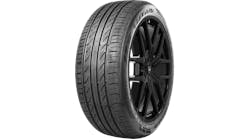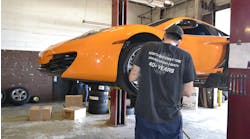The Abu Dhabi Grand Prix, at the spectacular Yas Marina circuit, is unique because it starts in the late afternoon and finishes at dusk. This puts a new complexion on the tyre evaluation work that is carried out during free practice on Friday, with a different pattern of ambient and track temperature evolution – and therefore tyre behavior – than usual. Normally temperatures rise during each session, but in Abu Dhabi (as well as at the night race in Singapore) they drop.
The second free practice session, which got underway at 5pm local time, was run in conditions that will be representative of tomorrow’s qualifying and Sunday’s race, with Red Bull driver Sebastian Vettel setting a fastest time of 1m41.751s on the P Zero Yellow soft tyre with half an hour to go. The 2012 soft tyre – used for 15 of this season’s 20 races – is having its final race weekend in Abu Dhabi, where it has been nominated alongside the P Zero White medium tyre.
As usual, during the first free practice session all the drivers used the medium tyre, which proved to be extremely durable despite track temperatures in excess of 45 degrees centigrade. The McLarens of Lewis Hamilton and Jenson Button were first and second fastest respectively, with Hamilton setting his benchmark time of 1m43.285s in the final half-hour of the 90-minute session. Hamilton was also second-fastest in FP2, a tenth of a second behind Vettel.
Conditions were quite different in the second session, with both track and air temperatures in the region of 30 degrees centigrade. Once the sun had set, just after half an hour into the session, track temperatures dropped further: putting the emphasis on the extra performance offered by the P Zero Yellow soft.
Toro Rosso’s Jean-Eric Vergne was the first driver to sample the soft compound, followed by the rest of the field as they evaluated longer runs on the soft compound with heavy fuel loads. This is the configuration that most of the teams will start the race with. The soft tyre showed consistent speed even after several laps, despite the heavy traction demands of the Marina Bay circuit that affect the rear tyres in particular. HRT’s Narain Karthikeyan was among the last to switch to the soft tyre, along with Lotus driver Kimi Raikkonen, who completed just 15 minutes on the softer compound and ended up sixth fastest. Vettel, Vergne and Marussia’s Timo Glock ended the session back on the medium tyre.
Pirelli’s motorsport director Paul Hembery commented: “Unlike the last grand prix in India, we don’t have a full step between the two compounds in Abu Dhabi. From what we can gather up to now, there is between 0.4s to 0.8s difference in performance between the soft and the medium tyres here, which was the improvement that Vettel made on the soft tyres compared to the medium on his initial runs. Durability is very good on both compounds, with low degradation, and, just as was the case last year, we can all easily see how all the teams have understood how to get the very most out of our tyres as their knowledge and data bank has increased towards the end of the season. As a result, we may even see some drivers trying one pit stop here during the race whereas last year two stops was Hamilton’s winning strategy – who has been very quick in every session so far as well. With a high degree of track evolution, we don’t believe we’ve seen the full picture at Yas Marina yet.”


